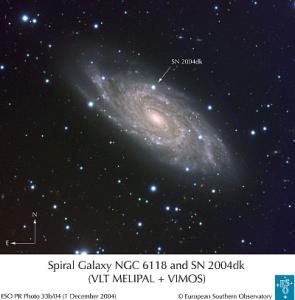Astronomers at Paranal Observatory (Atacama, Chile) caught this impressive image of the spiral galaxy NGC 6118, which is located near the celestial equator, in the constellation Serpens (The Snake). Note the bright star-like object indicated by the arrow. This is Supernova 2004dk, first reported on August 1, 2004; it’s a Type 1b or 1c supernova captured several days before maximum light.
 According to the European Southern Observatory, this kind of supernova is apparently the end of a massive star that lost its hydrogen envelope because of transfer of mass in a binary star system before exploding. Excuse the low-res image, but it’s hyperlinked to a higher-quality one (click on the image). An ESO press release on several supernova photographs and associated findings is available.
According to the European Southern Observatory, this kind of supernova is apparently the end of a massive star that lost its hydrogen envelope because of transfer of mass in a binary star system before exploding. Excuse the low-res image, but it’s hyperlinked to a higher-quality one (click on the image). An ESO press release on several supernova photographs and associated findings is available.
Image: A composite colour-coded image of the “grand design” spiral galaxy NGC 6118, at a distance of 80 million light-years. It is based on images obtained with the multi-mode VIMOS instrument on the ESO Very Large Telescope (VLT) in three different wavebands. The image covers 6.7 x 5.8 arcmin on the sky. North is up and East is to the left. The position of supernova SN 2004dk is indicated by the arrow. Credit: European Southern Observatory.

